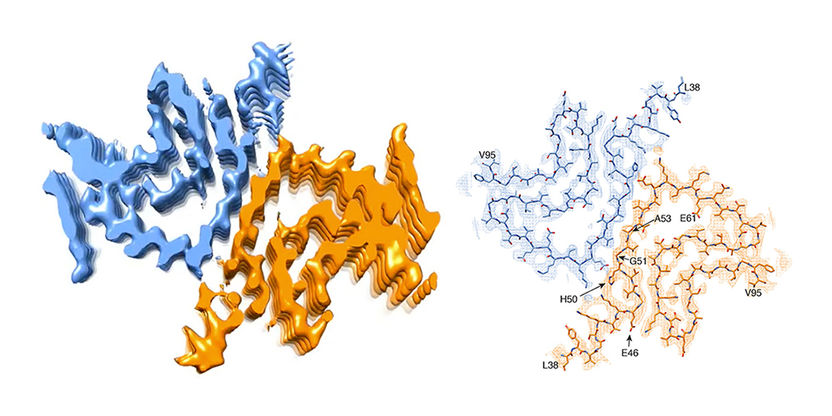How does Parkinson's disease develop?
Study raises doubts on a previous theory of Parkinson’s disease
Parkinson's disease was first described by a British doctor more than 200 years ago. The exact causes of this neurodegenerative disease are still unknown. In a study recently published in eLife, a team of researchers led by Prof. Henning Stahlberg from the Biozentrum of the University of Basel has now questioned the previous understanding of this disease.

Cross section of an alpha-synuclein fibril. Left: 3D reconstruction of the fibril, showing two interacting protein molecules. Right: atomic model of the fibril structure.
University of Basel
The arms and legs tremble incessantly, the muscles become weaker and the movements slower − these are typical symptoms that many Parkinson's patients suffer from. More than six million people are affected worldwide. In these patients, the dopamine-producing nerve cells in the brain slowly die off. The resulting lack of this neurotransmitter impairs motor function and often also affects the cognitive abilities.
Questionable: protein fibrils cause Parkinson's disease
So far, it was assumed that the protein alpha-synuclein is one of the trigger factors. This protein can clump together and form small needles, so-called fibrils, which accumulate and deposit as Lewy bodies in the nerve cells. These toxic fibrils damage the affected brain cells. A team of scientists led by Prof. Henning Stahlberg from the Biozentrum of the University of Basel, in collaboration with researchers from Hoffmann-La Roche Ltd. and the ETH Zurich, have now artificially generated an alpha-synuclein fibril in the test tube. They have been able to visualize for the first time its three-dimensional structure with atomic resolution. "Contrary to our expectations, the results seem to raise more questions than they can hope to answer," says Stahlberg.
It is important to know that in some congenital forms of Parkinson's disease, affected persons carry genetic defects in the alpha-synuclein gene. These mutations, it is suspected, eventually cause the protein to fold incorrectly, thus forming dangerous fibrils. "However, our 3D structure reveals that a mutated alpha-synuclein protein should not be able to form these type of fibrils," says Stahlberg. "Because of their location, most of these mutations would rather hinder the formation of the fibril structure that we have found." In brief, if the fibril structure causes Parkinson's disease, the genetic defect would have to protect against the disease. But this is not the case. So, it could be possible that a different type of fibril or another form of the protein triggers the disease in these patients.
Study poses new questions
More investigations are now needed to understand this fibril structure. What are the effects of the alpha-synuclein mutations? Do they lead to distinct forms of protein aggregates? What is the role of the fibrils for the nerve cells, and why do these cells die? To date, the exact physiological function of alpha-synuclein is still not known. Since only the symptoms of this neurodegenerative disease can be alleviated with the current medications, new concepts are urgently needed.
Original publication
Other news from the department science

Get the life science industry in your inbox
By submitting this form you agree that LUMITOS AG will send you the newsletter(s) selected above by email. Your data will not be passed on to third parties. Your data will be stored and processed in accordance with our data protection regulations. LUMITOS may contact you by email for the purpose of advertising or market and opinion surveys. You can revoke your consent at any time without giving reasons to LUMITOS AG, Ernst-Augustin-Str. 2, 12489 Berlin, Germany or by e-mail at revoke@lumitos.com with effect for the future. In addition, each email contains a link to unsubscribe from the corresponding newsletter.
Most read news
More news from our other portals
Last viewed contents
Immatics enters Collaboration with the National Cancer Institute (NCI) to Advance the Development of IMA950 for Glioblastoma - Multi-target therapeutic cancer vaccine IMA950 to enter second clinical phase I study for glioblastoma, the most aggressive form of brain cancer
Algeta elects US pharma industry executives Judith Hemberger and Kapil Dhingra to its Board of Directors

Analysis of single plant cells provides insights into natural product biosynthesis - Single-cell multi-omics reveals that cell types are differentially involved in the production and accumulation of medically relevant plant compounds
Nationales Centrum für Tumorerkrankungen Dresden (NCT/UCC) - Dresden, Germany
List_of_Banksia_species

Wastewater treatment plants as drivers for the energy transition - Technical add-on module can, in principle, turn any wastewater treatment plant into a CO2 sink and decentralized methane production plant
Sanofi and Google to develop new healthcare Innovation Lab



















































